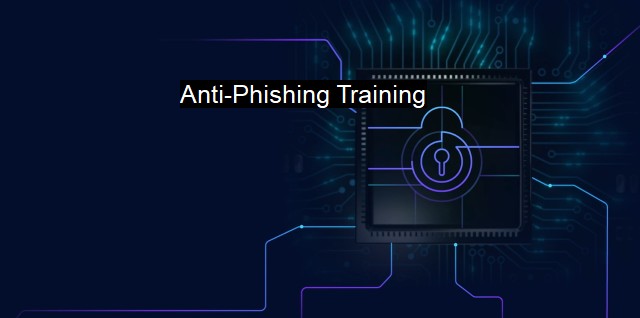What is Anti-Phishing Training?
Protect Your Business with Anti-Phishing Training: A Must-Have Component of Your Cybersecurity Strategy
Anti-phishing training is a specialized form of cybersecurity education focusing on instructing individuals on how to recognize, prevent, and respond to phishing attacks. In the current cyber landscape, phishing attacks remain one of the primary methods cyber criminals employ to exploit unsuspecting individuals, businesses, and even governments. Phishing techniques range from personalized, targeted attacks known as spear phishing to widespread, mass emails aiming to trap as many victims as possible. This prevalence of phishing necessitates anti-phishing training as a core component of a broader cybersecurity strategy.Phishing, at its core, entails tricking individuals into sharing sensitive information like usernames, passwords, or credit card details. It often comes camouflaged in the form of a seemingly legitimate communication from a bank, a service provider, or a known contact. The cybercriminal lures the unsuspecting individual to a counterfeit website or requests sensitive information directly. The counterfeited websites are usually a mirror image of legitimate websites and are designed exclusively to pilfer credentials.
Given this backdrop, the relevance and importance of anti-phishing training are undeniable. Comprehensive anti-phishing training involves several key aspects. Primarily, it aims to educate recipients about the diverse nature of phishing scams—each variant characterized by different levels of sophistication and different baiting techniques. It includes practical guidance on identifying suspicious communications like unexpected requests, spelling and grammar mistakes, generic greetings, unofficial email addresses, and manipulative language provoking immediate action.
Secondly, anti-phishing training endeavors to equip individuals with the knowledge and tools to verify the legitimacy of emails and websites. It explains how to check emails and websites' source and security, such as looking at the sender's email address carefully, checking for an absence of HTTPS, and verifying URL credibility. It also provides instructive guides on what steps to take if an individual suspects a phishing attempt. The typical steps involve not clicking on any links, not downloading any attached files, not providing any personal information, and reporting the incident to the relevant authorities.
Anti-phishing training is not a one-time event but an ongoing cyclic process. Cyber threats continually evolve, and phishing tactics become increasingly sophisticated. Consequently, continuous training updates are necessary to stay ahead of these threats. Frequent testing of acquired knowledge through simulated phishing attacks assesses the effectiveness of anti-phishing training, underpins learning, and helps develop a deep-rooted culture of cybersecurity awareness.
Business organizations can immensely benefit from anti-phishing training. It offers a practical, cost-effective means to mitigate the risk of cyber threats and potential data breaches. Strong passwords and efficient antivirus software are necessary, yet they remain susceptible to human error, making anti-phishing training an indispensable part of any cybersecurity infrastructure.
Anti-phishing training is a potent defense mechanism within the broader spectrum of cybersecurity. Its mainstay is education—furnishing individuals with the necessary knowledge to identify, prevent, and counteract phishing threats. Promoting users to develop healthy online habits, like skepticism towards unsolicited contact and verifying email origins, makes them more resilient against these phishing attacks. Comprehensive, ongoing anti-phishing training helps encourage a proactive approach to cybersecurity, bolstering individual and organizational protections and laying the foundation for sustained, safer interactions in the digital realm.

Anti-Phishing Training FAQs
What is anti-phishing training and how does it help with cybersecurity?
Anti-phishing training refers to educating individuals about the various phishing techniques used by cybercriminals. These techniques are used to steal sensitive information, such as usernames and passwords, by posing as a trusted source. This kind of training helps prevent individuals from falling victim to such attacks and helps improve overall cybersecurity.What are some common phishing techniques used by cybercriminals?
Some common phishing techniques used by cybercriminals include spear phishing, whaling, baiting, and pretexting. Spear phishing is where an attacker targets a specific individual or group, whereas whaling is when an attacker targets high-profile individuals like executives. Baiting refers to offering something of value, like a free gift, in exchange for personal information. Pretexting is when an attacker poses as a trustworthy person or entity to gain access to sensitive information.How can employees identify a phishing attempt?
Employees can identify a phishing attempt by looking out for tell-tale signs of a phishing email, such as spelling or grammatical errors, suspicious links or attachments, requests for personal information, and mismatched logos or branding. If something seems too good to be true, it probably is a phishing attempt. It is necessary to be cautious and always verify the sender and the message before clicking on any links or providing any sensitive information.How can I implement anti-phishing training in my organization?
You can implement anti-phishing training in your organization by hosting training sessions or workshops, sending out email newsletters or informational flyers, performing mock phishing tests, and providing relevant guides or literature on the topic. Additionally, it is important to keep up to date with common phishing techniques and share that knowledge with your employees. Engaging employees in regular anti-phishing training can help prevent cyber attacks, protect sensitive information and improve overall cybersecurity.| | A | | | B | | | C | | | D | | | E | | | F | | | G | | | H | | | I | | | J | | | K | | | L | | | M | |
| | N | | | O | | | P | | | Q | | | R | | | S | | | T | | | U | | | V | | | W | | | X | | | Y | | | Z | |
| | 1 | | | 2 | | | 3 | | | 4 | | | 7 | | | 8 | | |||||||